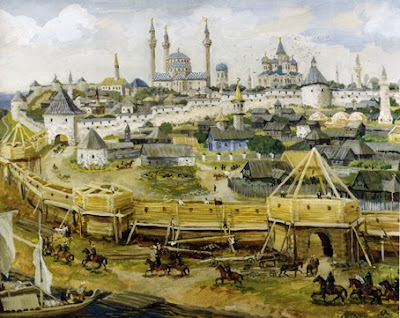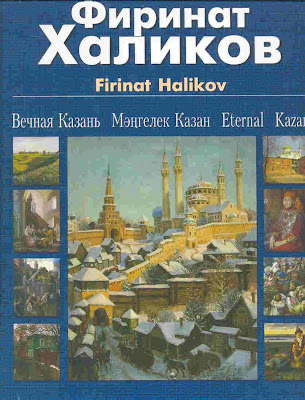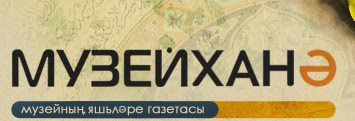Wednesday, April 27, 2011
Notes on Moscow Kremlin
Tuesday, April 26, 2011
Monday, April 25, 2011
Intertat Latincha

Татарстан Республикасы электрон газетасы - Latin Letters
Intertat.ru - Tatarstan Republic Electronic Newspaper
Sunday, April 24, 2011
August Haxthausen
The Tatar references in this is are quite intriguing.
This is through Google - books
Tatar Time

digital newspapaper / journal in Cyrillic - Tatar
and in Latin letters -Tatars
Thursday, April 21, 2011
Tatars in Japan 1935

Notes about the short lived Idel-Ural state
- January 1918
- Congress of Muslims from Russia’s Interior and Siberia proclaimed Independent State in the territory of Kazan and Ufa Governorates (guberni). Selection of the Government of the State, Milli Idare. Creation of VMVS (All-Russia Muslim Military Council). Election of Idel-Ural delegates to Versaille Conference.
- February 1918
- Non-Muslim nations of Chuvashia (Bolgaria), Udmurtia, Mari and Moksho-erzia (Mordovia) joined Tatars and Bashkirs in the new state.
- April 1918
- Red Army, after the Brest Peace Treaty was concluded, liquidated the state.
- July 1918
- With the help of the Czech Legion, the Idel-Ural administration was restored.
- End of 1918
- Troops of VMVS were incorporated into Kolchak’s White Army as the 16th Tatar Regiment and suffered decicive defeat at the hands of Red Army.
It was the end of the dream of recreating, also partially only, the State of the Golden Horde (Altin Ordu). It was to be a free federation of Turkic and Ugro-Finnic peoples of Volga-Ural Region, still remembering the glory of the Golden Horde. In 1920, against the wishes of at least Tatars and Bashkirs, the Soviets split all those nations into separate administrative units — divide and conquer.
"Idel", by the way, means "Volga" in a number of turkic languages: "Ӑтал | Ătal", in Chuvash; "İdil", in (Anatolian / Ottoman) Turkish;.
Description of the flag
The blue flag with the tamga (originally the Mongol branding mark, later heraldic device of Tatar and related nobility) was the unifying symbol of all those nations derived from the Golden Horde.
Monday, April 18, 2011
Sunday, April 17, 2011
Tatar Pride

During the McCarthy hearings he changed his last name to Bronson, as all Slavic sounding names were suspect despite the fact that his name was of Lithuanian origin, i.e. Baltic (westerners, at this time, made no distinction between Baltic and Slavic names.)
He was one of 15 children born to a Lithuanian immigrant father of Lipka Tatar ancestry and a Lithuanian mother. His father was from the town of Druskininkai. His mother, Mary Valinsky, whose parents were born in Lithuania, was born in the anthracite coal mining town of Tamaqua, Pennsylvania in northeastern Pennsylvania.
Dual Signage - Duel Signage
Tatar Australia Plaque

Tatar-Bashkurt plaque (1998)
Migration Museum Memorial Wall
This plaque is dedicated to the memory of Tatars & Bashkurts who lost their lives in the long struggle for a free nationhood, and for those who were forced to leave their country as a direct result of the policies of Russian imperialism and communism. God bless their souls.
1998
Zulfia, Tatar of Burabay Kazakhstan
Ancient Crimea. Medieval Crimea
Crimean Tatars were formed as a complex multi-ethnic group, consisting of both newcomers - the conquerors and the local Islamized and Turkicized population. Up until World War II remained a clear-cut separation of the Crimean Tatars on the main landscape zones. As special groups within the ethnic group in the anthropological and linguistically distinguished Tatars South Coast (southern Caucasians, language close to Turkish Oghuz Turkic sub-branch of the Altaic family), Tatars of the steppe (the predominance of Mongoloid features, language Kipchak subgroups), an intermediate position occupied by the Tatars foothill zone . Later, as a result of deportation and subsequent return as a territorial, this structure has ceased to exist. "
the mouseover maps are very cool.

Thursday, April 14, 2011
Tatar Ethnic Footwear
http://luiza-m.narod.ru/foto/ayaqkieme.htm
Tatar Milli Ayakkiemlere
Tatar Folk Footwear
Tatars in Russian Literature Painting and Film
"Means of Tatars in the Russian literature and also in the painting and the cinematography"
http://tatar-rulit.livejournal.com/
in Russian
Tuesday, April 12, 2011
Monday, April 11, 2011
Wednesday, April 6, 2011
Russian Bears

 This is a shop in our part of town in San Francisco. These sure look like Russian bears to me.
This is a shop in our part of town in San Francisco. These sure look like Russian bears to me.It's the red stars that do it.
The Russian Bear is a national personification for Russia, used in cartoons and articles and dramatic plays at least since the 17th century, and relating alike to Tsarist Russia, the Soviet Union and the Russian Federation.
It often was and is used by Westerners, to begin with especially in Britain and later also in the US, and not always in a flattering context — on occasion used to imply that Russia is "big, brutal and clumsy". The bear image was, however, on various occasions (especially in the 20th century) also taken up by Russians themselves. Having the teddy bear "Misha" as the mascot of the 1980 Moscow Olympic Games — boycotted by numerous countries due to the invasion of Afghanistan. Russia — was evidently intended to counter the "big and brutal Russian Bear" image with a small, cuddly and smiling bear.
After the collapse of the Soviet Union, there was some support in the Russian Parliament for having a bear as the new Russian coat of arms — with the proposers pointing out that "Russia is anyway identified in the world with the Bear" — though eventually it was the Tsarist coat of arms of the Double-headed eagle that was restored.
Later, the bear was taken up as the symbol of the United Russia Party, which dominates the political life in Russia since the early 2000s. Coincidentally, the surname of Dmitry Medvedev, the Russian president elected in 2008, is the possessive adjective of медведь: i.e. his surname is "bear-owner".



































